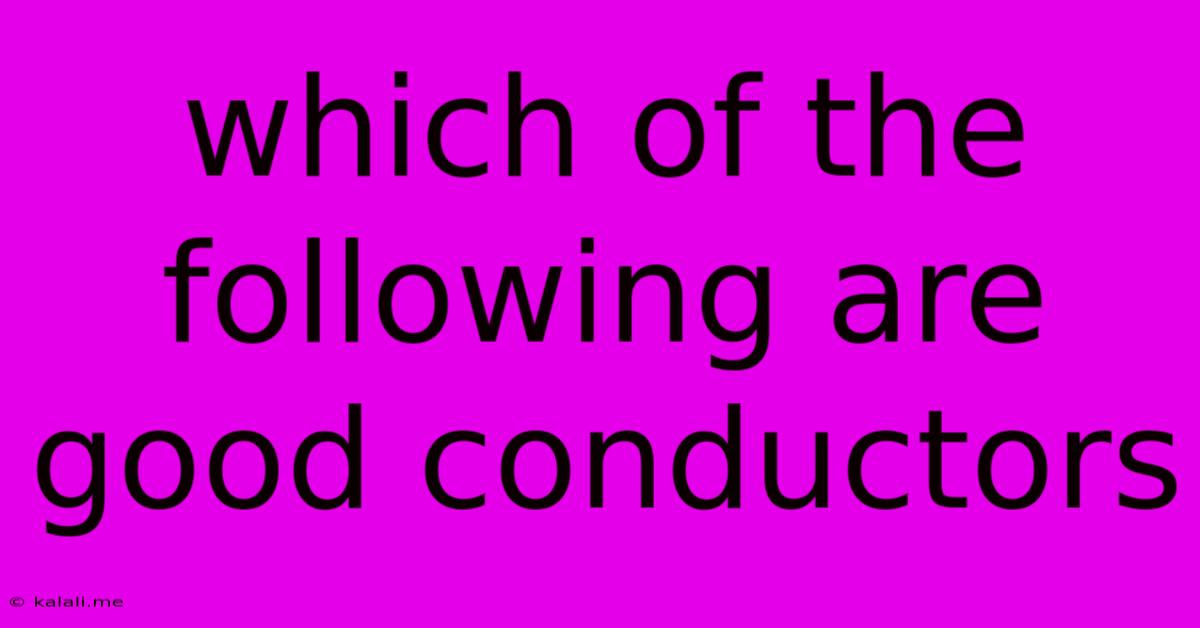Which Of The Following Are Good Conductors
Kalali
Jun 14, 2025 · 3 min read

Table of Contents
Which of the Following Are Good Conductors? Understanding Electrical Conductivity
This article explores the concept of electrical conductivity and helps you identify good conductors from a list of materials. Understanding conductivity is crucial in various fields, from electronics and electrical engineering to material science. We'll delve into the properties that make a material a good conductor and provide examples.
What is Electrical Conductivity?
Electrical conductivity refers to a material's ability to allow the flow of electric current. This flow is facilitated by the movement of electrically charged particles, typically electrons. Materials with high conductivity offer little resistance to this flow, while materials with low conductivity (insulators) significantly impede it. The ease with which electrons can move through a material depends on its atomic structure and bonding.
Factors Affecting Electrical Conductivity:
Several factors influence a material's conductivity:
- Atomic Structure: Materials with loosely bound electrons, often found in metals, are excellent conductors. These electrons are free to move throughout the material, readily carrying an electric current.
- Temperature: Generally, conductivity decreases as temperature increases. Increased thermal energy causes more vibrations within the material's structure, hindering the free movement of electrons.
- Impurities: The presence of impurities in a material can significantly affect its conductivity. Impurities can scatter electrons, increasing resistance.
- Material Type: Different materials exhibit vastly different conductivity levels. Metals are typically excellent conductors, while non-metals tend to be insulators.
Good Conductors vs. Insulators:
The key difference between good conductors and insulators lies in their electron mobility. Good conductors have a "sea" of freely moving electrons, while insulators tightly bind their electrons, preventing significant electron flow. Here's a simple comparison:
| Feature | Good Conductors | Insulators |
|---|---|---|
| Electron Mobility | High | Low |
| Resistance | Low | High |
| Examples | Copper, Silver, Gold, Aluminum | Rubber, Glass, Wood, Plastics |
Identifying Good Conductors from a List:
To determine which materials from a given list are good conductors, consider the following:
- Metals: Almost all metals are excellent conductors. Look for elements from the periodic table's transition metal groups or alkali metals.
- Graphite: A notable exception among non-metals, graphite's structure allows for some electron mobility, making it a relatively good conductor.
- Electrolytes: Solutions containing ions (charged atoms) can also conduct electricity. However, this is ionic conductivity, different from the electronic conductivity in metals.
Examples of Good Conductors:
- Copper (Cu): Widely used in electrical wiring due to its high conductivity and affordability.
- Silver (Ag): The best electrical conductor, but its high cost limits its use in most applications.
- Gold (Au): Excellent conductivity and resistance to corrosion make it ideal for high-quality electronics.
- Aluminum (Al): A lighter and cheaper alternative to copper, often used in power transmission lines.
Conclusion:
Understanding electrical conductivity is essential for selecting appropriate materials for various applications. By considering the atomic structure, temperature, and presence of impurities, one can effectively identify good conductors. Remember, metals generally excel as conductors, but some exceptions exist, such as graphite. Always consult reliable resources for specific material properties.
Latest Posts
Latest Posts
-
How Many Unpaired Electrons Does Mg Have
Jun 14, 2025
-
A Group Of Stars Is Called
Jun 14, 2025
-
What Is The Unit For Strain
Jun 14, 2025
-
What Is The Hybridization Of The Central Atom In Pcl3
Jun 14, 2025
-
Which One Of The Following Is Not A Supply Chain Strategy
Jun 14, 2025
Related Post
Thank you for visiting our website which covers about Which Of The Following Are Good Conductors . We hope the information provided has been useful to you. Feel free to contact us if you have any questions or need further assistance. See you next time and don't miss to bookmark.